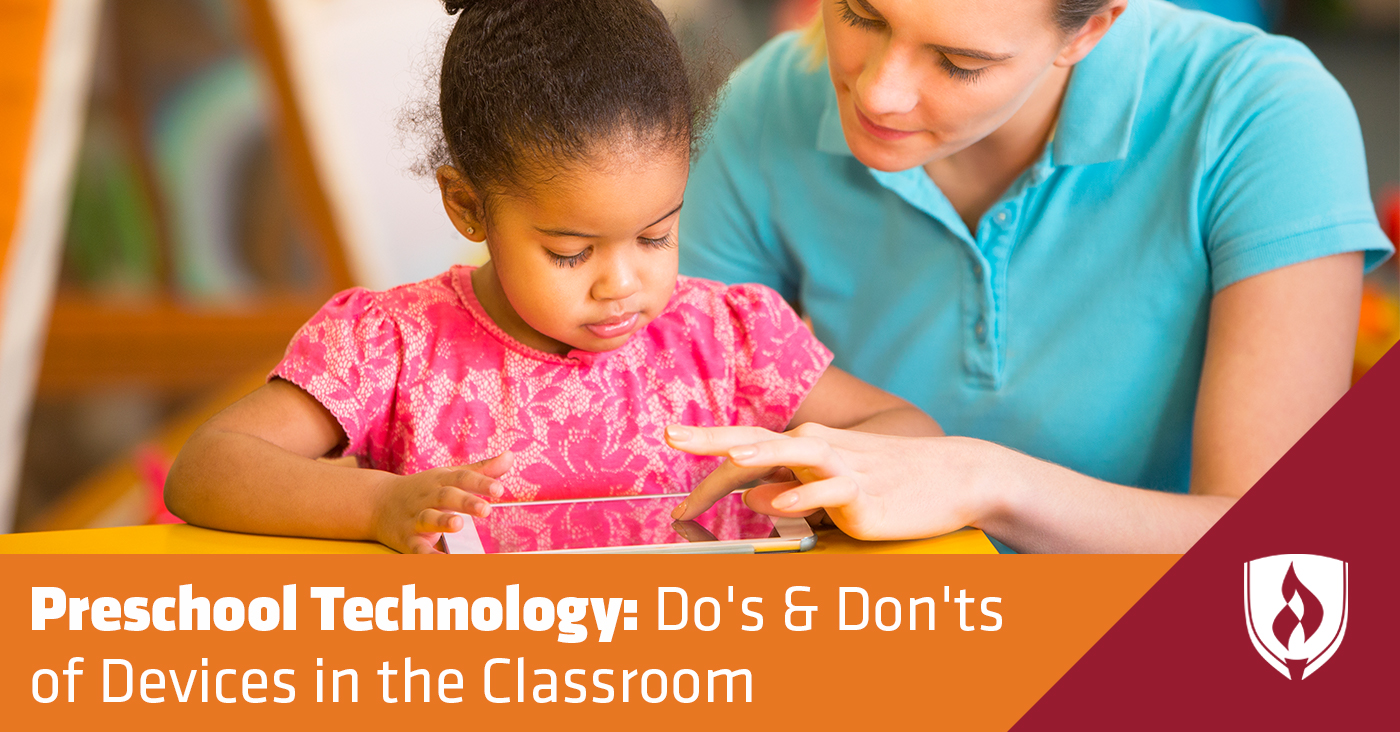The use of technology in a preschool classroom might seem outrageous to those who grew up before the boom of personal computers. But with the ever-growing number of gadgets and personal devices making their way into our lives, it’s practically inevitable that young children will get their hands on mobile devices like tablets.

The emergence of preschool technology has spurred debate over whether these devices are helpful, harmful, or somewhere in between. Rasmussen College School of Education dean Mary Muhs thinks the use of tablets by young children is unavoidable and not necessarily a bad thing.
“Children are born with the digital world as much a part of their life as crayons and blocks—we can’t withhold it from [them],” Muhs says. She believes adults have the responsibility to help children understand the capabilities and benefits of these devices while managing children’s usage and time.
"Children are born with the digital world as much a part of their life as crayons & blocks."
There are plenty of teachers and parents who choose to incorporate mobile devices into their classroom curriculum or their own children’s at-home learning routine. If you fall into that category, we enlisted some early childhood educators to share some tips and tricks to help you navigate this new territory of preschool technology.
Do’s & Don’ts of preschool technology
What to do:
DO set guidelines for caring for devices with children early on. Make sure children understand these devices need to be used gently. It’d also be wise to invest in screen covers and cases for devices to help prevent any expensive accidents.
DO try to find apps or games for children that are interactive, age appropriate and can encourage participation from parents or caregivers, suggests Dr. Rebecca Palacios, senior curriculum adviser for Age of Learning. She says it’s important for young children to have the feedback of an adult when using electronic devices.
Palacios believes quality time with a parent or caregiver is extremely important –especially for children between two and three. She says adult interaction can help encourage children to elaborate on what they’re seeing or hearing. “It’s not about passively using technology, but applying it so children can learn and grow from it,” she explains.
"It's not about passively using technology, but applying it so children can learn and grow from it."
DO monitor device usage with a device like you would with a television. Muhs says it’s important to limit screen time for children so they can develop the social and physical skills that come with interaction with others and the world around them.
DO use technology strategically. Dr. Palacios says the classrooms she ran as a teacher integrated technology as a way to enhance a lesson plan or theme. A game or application on an electronic device is just another tactic to reinforce what children are learning in other hands-on activities. For example, a counting game or activity on a tablet fits into a theme of numerical literacy—it’s not just using technology for the sake of technology.
What NOT to do:
DON’T use screen time to replace personal interaction. It’s important to remember the world is still a new place for toddlers. We may be content staring at a tablet for several hours, but there are still a lot of seemingly simple concepts little ones have yet to master. Muhs says the traditional approach is still vitally important to child development.
“Interacting with children through conversation and play will always deliver a higher benefit for development than any game or video on a device,” says Muhs, “Nothing replaces you!”
DON’T let children under the age of two use tablets, according to Dr. Robert Myers, behavioral therapist and contributor to EmpoweringParents. He says that while there is no conclusive research proving mobile devices change the ability of a child to delay gratification, there are studies that show television viewing by young children may lead to issues with attention and concentration later in life. Myers recommends parents and teachers adhere to the American Academy of Pediatrics guideline of no more than 2 hours of exposure to electronic media in a day for children older than two.
“The growing brain is definitely affected by environmental stimulation,” Myers says. “Parents should encourage activities that encourage interaction with their child's environment and the people in it.”
DON’T use time with a tablet or smart phone as a reward for positive behavior. Muhs says this sends the wrong message to children, as a child’s motivation for good behavior shouldn’t be bought.
“Behavioral expectations should come from the situation, not from bribery,” says Muhs.
Embrace the future
There’s no stopping it—the amount of technology and mobile devices children encounter will continue to grow. It’s important for parents and educators to know how to manage this usage responsibly while finding ways to leverage the learning opportunities children can have with preschool technology. Mobile devices may be more complex than blocks or crayons, but when used strategically they are just like any other tool in the metaphorical child development toolbox.
You may not realize it, but the little things you do every day – like reading to your children or teaching them a new skill – might just be a sign that you’d make a great teacher. For more ‘signs’ of your potential excellence as an educator, check out 9 Signs You Should Be a Teaching Preschool.
Related Articles:




